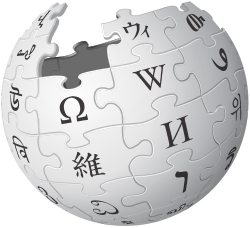
Back সাহায্য:আধ্বব/ফার্সি Bengali/Bangla Help:IPA/Persian English راهنما:الفبای آوانگاری بینالمللی فارسی Persian विकिपीडिया:IPA for Persian Hindi Aiuto:AFI/Persian LLD ਮਦਦ:ਫ਼ਾਰਸੀ ਲਈ IPA Punjabi معاونت:بین الاقوامی اصواتی ابجدیہ برائے فارسی Urdu Help:波斯語國際音標 Chinese
| Bagian dari seri tentang |
| Halaman Bantuan Wikipedia Bahasa Indonesia |
|---|
 |
Pengucapan kosa kata bahasa Inggris di Wikipedia disalurkan dengan Alfabet Fonetis Internasional (IPA) memakai transkripsi berikut, yang tidak spesifik pada satu dialek apapun. Untuk pengenalan dasar IPA, lihat Wikipedia:IPA/Pengenalan. Jika Anda merasa perlu menambahkan pengejaan pengucapan, gunakan konvensi kunci pengejaan pengucapan Wikipedia. Untuk kunci IPA yang lebih lengkap, lihat Wikipedia:IPA, yang dilengkapi suara yang tidak muncul dalam bahasa Inggris. Jika simbol IPA tidak tertampil dengan baik pada peramban Anda, lihat pranala di bawah halaman.
Tabel di bawah ini menunjukkan bahasa Persia dalam simbol-simbol IPA. Lihat Fonologi bahasa Persia untuk lebih dalam mengenai bunyi dalam bahasa Persia.
|
| |||||||||||||||||||||||||||||||||||||||||||||||||||||||||||||||||||||||||||||||||||||||||||||||||||||||||||||||||||||||||||||||||||||||||||||||||||||||||||||||||||||||||||||
- ^ Konsonan bahasa Persia dapat dipanjangkan, terutama pada kata-kata dari bahasa Arab. Dalam Ipa diwakilkan dengan menggandakan simbol konsonan, seperti: [sejjed].
- ^ Juga sebuah alofon dari /p/ sebelum konsonan bersuara.
- ^ Juga sebuah alofon dari /k/ sebelum konsonan bersuara.
- ^ Juga sebuah alofon dari /x/ sebelum konsonan bersuara.
- ^ غ dan ق menyatakan fonem dalam bahasa Persia Klasik yang berasal dari bahasa Arab, the voiced velar fricative [ɣ] and the voiceless uvular stop [q] (pronounced in Persian as voiced uvular stop [ɢ]), respectively. In modern Tehrani Persian (both colloquial and standard dialects), the phonemes of غ and ق are allophones; when /ɣ/ (spelled either غ or ق) occurs at the beginning and the end of a word, post-consonantal position, and syllable-final position, it is realized as a voiced uvular plosive [ɢ], when /ɢ/ (also spelled either غ or ق) occurs intervocalically, it is realized as a voiced velar fricative [ɣ]; the allophone is probably influenced by Turkic languages like Azeri and Turkmen. The sounds remain distinct in Persian dialects of southern Iran and Eastern Persian dialects (Dari and Tajik).
- ^ a b c d The unvoiced stops /p, t, tʃ, k/ are aspirated much like their English counterparts: they become aspirated when they begin a syllable, though aspiration is not contrastive.
- ^ Juga sebuah alofon dari /n/ sebelum konsonan dwibibirs.
- ^ A trilled allophone [r] occurs word-initially (Spanish/Italian/Russian R); trill [r] as a separate phoneme occurs word-medially especially in loanwords of Arabic origin as a result of gemination of [ɾ].
- ^ While و is pronounced [v] in Iranian Persian, it is pronounced as [w] in Dari.
- ^ [v] is also an allophone of [f] before voiced consonants.
- ^ Juga sebuah alofon dari /s/ sebelum konsonan bersuara.
- ^ Juga sebuah alofon dari /ʃ/ sebelum konsonan bersuara.
- ^ Velar nasal [ŋ] is an allophone of /n/ before [g], [k], [ɣ], [ɢ], and [x] in native vocabulary.
- ^ Stress falls on the last stem syllable of most words. For the various exception and other clarifications, see Persian phonology#Stress
- ^ a b c In the modern Persian script, the "short" vowels /æ/, /e/, /o/ are usually not written as is done in the Arabic alphabet; only the long vowels /ɒː/, /iː/, /uː/ are represented in the text. This, of course, creates certain ambiguities.
- ^ [e] is also an allophone of /æ/ in word-final position in contemporary Iranian Persian.
- ^ The Persian /e/ doesn't quite line up with any English vowel, though the nearest equivalents are the vowel of bate (for most English dialects) and the vowel of bet; the Persian vowel is usually articulated at a point between the two.
- ^ The Persian /o/ doesn't quite line up with any English vowel, though the nearest equivalents are the vowel of boat (for most English dialects) and the vowel of raw; the Persian vowel is usually articulated at a point between the two.
- ^ /ou/ becomes [o] in colloquial Tehrani dialect but is preserved in other Western dialects and standard Eastern Persian.

